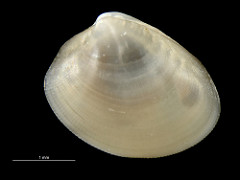Large nut shell
| Large nut shell | ||||||||||||
|---|---|---|---|---|---|---|---|---|---|---|---|---|

Large nut clam ( Nucula nucleus ) |
||||||||||||
| Systematics | ||||||||||||
|
||||||||||||
| Scientific name | ||||||||||||
| Nucula nucleus | ||||||||||||
| ( Linnaeus , 1758) |
The Big Nut Shell ( Nucula nucleus , too) Common walnut shell called, is a shell - type from the family of nuculidae (Nuculidae).
features
The housing is approximately triangular in outline and is up to about 1.3 cm long. The small, forward-facing vertebra sits behind the center, i.e. H. the case is longer at the front than at the back. The front end is well rounded, the rear end is trimmed. The surface shows fine concentric growth lines and very fine radial lines that are barely visible to the naked eye. The lock or lock line is bent at an angle (approx. 95 to 100 °) and is therefore divided into a front and a rear part. It consists of a series of uniform teeth and tooth pits; there are 16 to 25 teeth at the front and 11 to 14 teeth at the back. The forward ligament pit is sunk under the vertebra between the two groups of teeth. The flap edges are serrated. The anterior and posterior sphincter muscles are approximately the same size. The jacket line is only weakly pronounced and has no jacket bay. The animals do not have siphons . The mouth lobes have long appendages covered with eyelashes, the so-called mouth lobes. The very mobile foot has a sole with serrated edges. The mineral shell is made up of three aragonitic layers, the inner layer consists of layered mother-of-pearl plates, the middle layer of pillar-like mother -of-pearl plates , and the outer layer of the shell is made up of denticular prismatic structures. Above that follows the thin, organic periostracum . The edge of the case is finely indented due to the prismatic-dental structures of the upper mineralized shell layer. The periostracum is yellowish, yellow-green, greenish-brown to gray, rarely with orange or purple-gray welts; the surface is matt. The inside of the flaps has a pearly sheen . The surface, especially at the rear end, is often covered with manganese deposits . The shell itself is whitish.
Geographical distribution and habitat
The large nut clam is found in the coastal areas of the eastern Atlantic from Norway to South Africa , and it also penetrates the North Sea , the Mediterranean Sea and the Black Sea .
It lives buried close to the sediment surface on fine sand and silt soils from about 10 meters water depth to about 1000 meters water depth.
Way of life
Since the large nut shell has no siphons through which the water flows in and out, the water is transported into the mantle cavity by means of cilia on the gills and mouth lobes and filtered between the gills. The food particles filtered out by the gills, however, represent only the smaller part of the food. The larger part is absorbed by the pair of mouth flap buttons fitted with eyelashes. The probes are moved over the surface of the sediment and the food particles ( detritus ) are brought to the mouth by the movement of the eyelashes. The large nut shell is very agile. The sole of the foot can be folded together and pressed into the sediment with the jagged edges laid together. Then the sole is unfolded again, the foot is anchored and the body with the housing can be pulled along.
Taxonomy
The taxon was introduced into scientific literature by Carl von Linné in 1758 as the Arca nucleus . It is the type species of the genus Nucula Lamarck, 1799.
supporting documents
literature
- S. Peter Dance, Rudo von Cosel (arrangement of the German edition): The great book of sea shells. 304 p., Verlag Eugen Ulmer, Stuttgart 1977, ISBN 3-8001-7000-0 , p. 222
- Rudolf Kilias: Lexicon marine mussels and snails. 2nd edition, 340 p., Verlag Eugen Ulmer, Stuttgart 1997, ISBN 3-8001-7332-8 , p. 219
- Fritz Nordsieck : The European sea shells (Bivalvia). From the Arctic Ocean to Cape Verde, the Mediterranean Sea and the Black Sea. 256 p., Gustav Fischer Verlag, Stuttgart 1969, p. 4
- Guido Poppe and Yoshihiro Goto: European Seashells Volume 2 (Scaphopoda, Bivalvia, Cephalopoda) . 221 pp., Verlag Christa Hemmen, Wiesbaden 1993 (2000 unc. Reprint), ISBN 3925919104 , p. 37
- Rainer Willmann: Mussels and snails of the North and Baltic Seas. 310 p., Neumann-Neudamm, Melsungen 1989, ISBN 3-7888-0555-2 , p. 81/2
On-line
Individual evidence
- ^ Theodor CH Cole: Dictionary of Invertebrates / Dictionary of Invertebrates: Latin-German-English. Springer Spektrum, Berlin 2017, ISBN 978-3-662-52869-3 , p. 59. Preview on Google Books
- ↑ Clare P. Glover, Susan M. Kidwell: Influence of Organic Matrix on the Post-Mortem Destruction of Molluscan Shells. The Journal of Geology, 101 (6): 729-747, 1993 online at JSTOR
- ^ Richard Neill Kilburn: The family Nuculidae (Bivalvia: Protobranchia) in South Africa and Mozambique. Annals of the Natal Museum, 40: 245-268, 1999 PDF
- ^ Carl von Linné: Systema naturae per regna tria naturae, secundum classes, ordines, genera, species, cum characteribus, differentiis, synonymis, locis. Tomus I. Editio decima, reformata. Pp. 1–824, Holmiae / Stockholm, Salvius, 1758. Online at Göttinger Digitization Center (p. 695 as Arca nucleus ).
- ↑ World Register of Marine Species: Nucula nucleus (Linnaeus, 1758)
